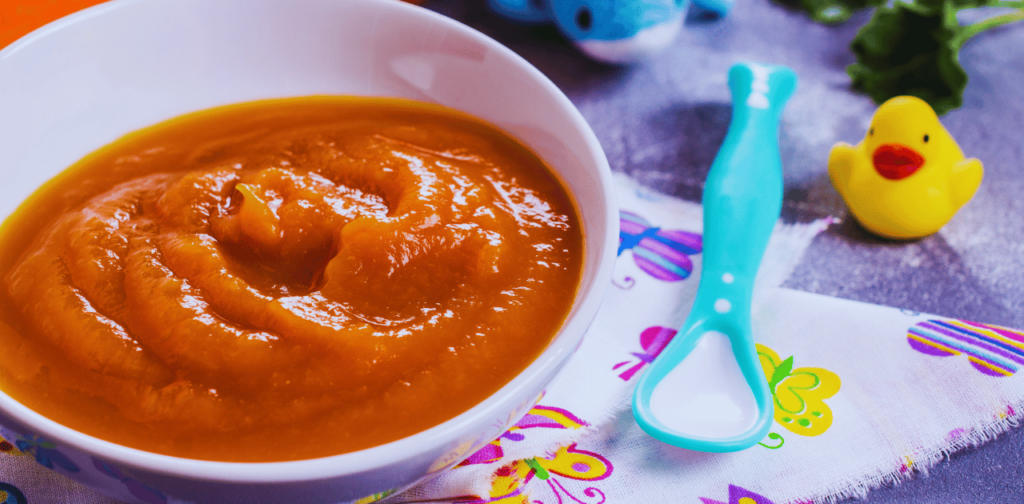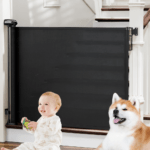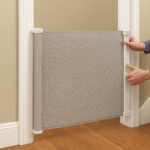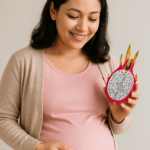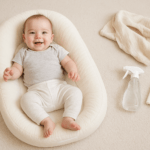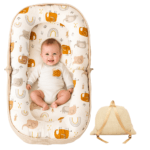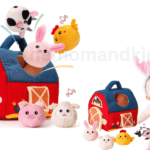Making your baby food is a fantastic way to ensure your little one gets nutritious meals. However, understanding how long homemade baby food lasts and the best storage practices is crucial for your baby’s safety and health. Without the preservatives in store-bought options, homemade baby food has a shorter shelf life. This guide will walk you through essential storage tips to maximize the freshness and safety of your homemade baby food. From the refrigerator to the freezer and everything in between, you’ll learn how to properly store, label, and handle your baby’s food to keep it as fresh and nutritious as possible.
So, let’s dive into the essentials of storing homemade baby food effectively!
Importance of homemade baby food
Making homemade baby food is an excellent way to ensure your child gets the best start with fresh, nutritious meals. Here’s why homemade baby food is essential:
- Control Over Ingredients: You have complete control over what goes into your baby’s food. This means avoiding preservatives, added sugars and other unwanted additives commonly found in store-bought options.
- Nutritional Value: Freshly prepared baby food retains more vitamins and minerals than commercially processed foods. You can also tailor the nutrient profile to meet your baby’s dietary needs.
- Cost-Effective: Preparing baby food at home can be more economical than buying pre-packaged options. Bulk buying and utilizing seasonal produce can further reduce costs.
- Taste and Texture Customization: Homemade baby food allows you to introduce your baby to various tastes and textures, which can help develop their palate and make them more accepting of different foods as they grow.
- Bonding and Education: Making baby food can be a bonding experience. It’s also an excellent opportunity to model healthy eating habits and teach your child about the importance of nutrition.
Types of Homemade Baby Food and Their Shelf Lives
Different types of homemade baby food have varying shelf lives depending on their composition and storage methods. Here’s a breakdown of the shelf lives for purees, mashed foods, and combination foods:
Purees
Purees are smooth and blended foods, often the first solid food introduced to babies.
- Shelf Life in the Refrigerator: Purees can be stored for 48 hours. To maintain freshness, ensure they are kept in airtight containers.
- Shelf Life in the Freezer: Purees can last up to three months when frozen. For portioning and ease of use, use freezer-safe containers or silicone ice cube trays easy portioning.
- Signs of Spoilage: Look for color, texture, and smell changes. Spoiled purees may develop a sour odor, a dull color, or a slimy texture.
Mashed Foods
Mashed foods are slightly chunkier than purees and often include mashed potatoes, avocados, or bananas.
- Shelf Life in the Refrigerator: Mashed foods can be stored for 48 hours in airtight containers. As with purees, use airtight containers to preserve their quality.
- Shelf Life in the Freezer: These can also be frozen for up to three months. However, some mashed foods, like avocados, may experience changes in texture after freezing.
- Signs of Spoilage: Check for off smells, discoloration, or changes in texture. When spoiled, mashed foods may become watery or develop a strange texture.
Combination Foods
Combination foods are mixtures of different ingredients, such as meats, vegetables, and grains, often prepared into a blended or chunky consistency.
- Shelf Life in the Refrigerator: Combination foods should be stored in the refrigerator for 48 hours. Due to the variety of ingredients, proper storage is essential to prevent spoilage.
- Shelf Life in the Freezer: These foods can also be frozen for up to three months. Portioning them into small servings can help manage thawing and usage.
- Signs of Spoilage: Look for any separation of ingredients, unusual smells, changes in color, or mold. Combination foods can spoil faster due to the mix of different ingredients, so careful observation is needed.
General Tips for All Types
- Labeling: Always label containers with the date of preparation to track how long the food has been stored.
- Portion Control: Freezing in small portions, like using ice cube trays, makes it easier to thaw only what you need.
- Avoid Refreezing: Do not refreeze thawed food, as this can compromise safety and quality.
- Check for Spoilage: Always inspect the food before feeding it to your baby. If in doubt, discard the food.
Benefits of Making Your Baby Food
Nutritional Benefits
- Control Over Ingredients: Making your baby food allows you to choose high-quality, fresh ingredients and avoid additives and preservatives.
- Tailored Nutrition: You can customize the nutrient content to meet your baby’s specific dietary needs, ensuring they get a balanced diet.
- Freshness: Homemade baby food often retains more vitamins and minerals than store-bought options, which can lose nutrients during processing and storage.
Cost-Effectiveness
- Lower Costs: Preparing baby food at home is generally more economical than purchasing pre-packaged options. Bulk buying and using seasonal produce can further reduce costs.
- Waste Reduction: Making your own baby food allows you to prepare just the right amount, reducing waste.
- Multi-Purpose Ingredients: Many ingredients you use for your baby’s food can also be part of your meals, increasing efficiency and reducing overall food costs
Read to know: Steaming Essentials: How to Steam Food For Baby
Understanding Homemade Baby Food Shelf Life
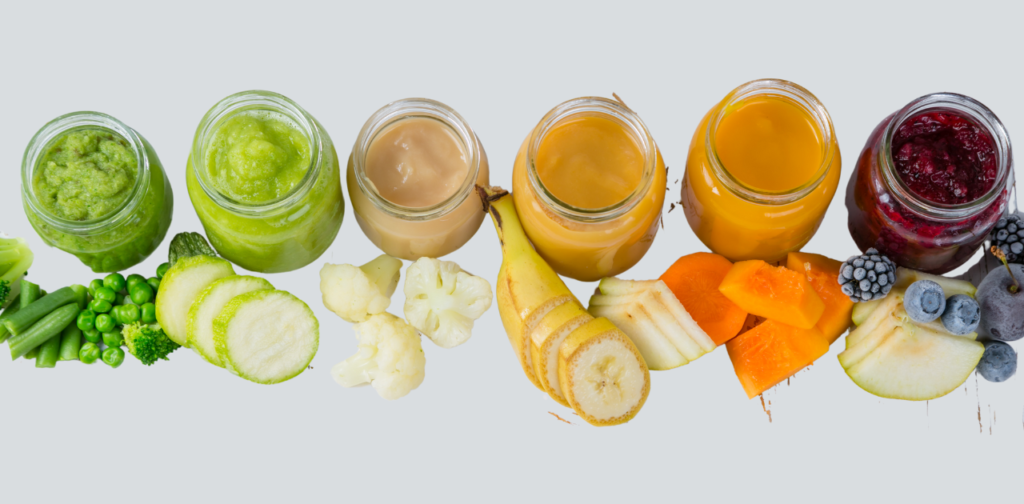
Ensuring the safety and quality of homemade baby food involves understanding its shelf life. Several factors influence how long homemade baby food remains fresh and suitable for consumption, and there are notable differences between homemade and store-bought baby food.
Factors Influencing Shelf Life
- Ingredients: The type of ingredients used significantly impacts shelf life. Fresh fruits and vegetables, especially those with high water content, like cucumbers and melons, spoil faster than root vegetables or grains.
- Preparation Method: How you prepare the food—whether cooked, steamed, or raw—affects its longevity. Cooked foods generally last longer than raw purees.
- Storage Conditions: Proper storage is crucial. Homemade baby food should be stored in airtight containers and at the correct temperature. Refrigeration is suitable for short-term storage, while freezing is ideal for longer-term preservation.
- Hygiene Practices: Good hygiene during preparation, such as washing hands and utensils thoroughly, can prevent contamination and extend shelf life.
- Temperature Fluctuations: Consistent temperature control is essential. Frequent changes from cold to warm can encourage bacterial growth, reducing the food’s shelf life.
Differences Between Homemade and Store-Bought Baby Food
- Preservatives: Store-bought baby food often contains preservatives to extend its shelf life, which can keep it safe to consume for months, sometimes even years. Homemade baby food lacks these preservatives, making it more perishable.
- Packaging: Commercial baby food is packaged under sterile conditions and vacuum-sealed to maintain freshness. Homemade baby food, typically stored in reusable containers, doesn’t benefit from such packaging technologies.
- Nutrient Retention: When freshly prepared, homemade baby food generally retains more nutrients than store-bought food, which may lose some nutritional value during processing and long storage periods.
- Additives: Store-bought varieties may include texture, flavor, and color consistency additives. Homemade baby food is free from these additives, which can benefit your baby’s health but may result in a shorter shelf life.
- Personalization: Homemade baby food can be tailored to your baby’s nutritional needs and taste preferences. This customization isn’t possible with store-bought options, which are produced for a general audience.
How to Store Homemade Baby Food
Storing homemade baby food correctly is crucial to maintaining its freshness, safety, and nutritional value. Here are some essential tips on how to store homemade baby food effectively:
Refrigeration
Homemade baby food can typically be stored in the refrigerator for 48 hours. Some sources suggest extending this to 72 hours, but to ensure the highest safety and freshness, it’s best to use the food within 48 hours.
- Short-Term Storage: Homemade baby food can be stored in the refrigerator for 48 hours. Some sources suggest up to 72 hours, but to err on caution, 48 hours is safer.
- Containers: Use airtight containers to prevent contamination and maintain freshness. Glass jars or BPA-free plastic containers work well.
- Labeling: Always label the containers with the date of preparation to track how long the food has been stored.
Freezing
When stored properly, homemade baby food can last up to three months in the freezer. Beyond this period, the food may still be safe but lose some nutritional value and taste.
- Long-Term Storage: Freezing is the best option for longer storage. Homemade baby food can be safely stored in the freezer for up to three months.
- Portion Sizes: Freeze the food in small portions, such as ice cube trays or silicone molds. This makes it easy to thaw just what you need.
- Containers: Once frozen, transfer the cubes into labeled freezer-safe bags or containers to save space and ensure proper storage.
- Thawing: Thaw baby food in the refrigerator overnight or use a warm water bath. Avoid using the microwave, which can create hot spots and uneven heating.
Best Practices
- Hygiene: Maintain high hygiene standards during preparation and storage. Wash your hands, utensils, and containers thoroughly before use.
- Cooking: Ensure food is cooked to the appropriate temperature to kill harmful bacteria.
- Cooling: Allow hot food to cool before placing it in the refrigerator or freezer to avoid raising the temperature inside the appliance.
- Avoid Refreezing: Do not refreeze thawed baby food, which can encourage bacterial growth and degrade quality.
- Check for Spoilage: Always check for signs of spoilage before feeding your baby. Look for color, texture, or smell changes, and discard any questionable food.
How Do I Reheat Frozen Homemade Baby Food?
Reheating frozen homemade baby food requires careful handling to ensure it remains safe and maintains its nutritional quality. Here are some methods to consider:
- Thaw in the Refrigerator:
Transfer the frozen baby food to the refrigerator the night before using it. This allows it to thaw slowly and evenly without compromising its texture or nutritional value.
- Warm Water Bath:
If you need to thaw the baby food quickly, place the container in a bowl of warm water. Ensure the water is not too hot, which can cook the food or create hotspots.
- Reheating on the Stove:
Once thawed, heat the baby food on the stove over low to medium heat. Stir frequently to avoid sticking and ensure it heats evenly. Avoid boiling the food.
- Microwave Method:
If you use a microwave, heat the baby food in a microwave-safe container. Set the microwave to a low power level to avoid overheating and creating hot spots. Stir frequently and ensure the food reaches a safe temperature before feeding it to your baby.
Impact of Ingredients on Shelf Life

The ingredients used in homemade baby food play a significant role in determining its shelf life. Different types of foods have varying spoilage rates, impacting how long they can be safely stored.
Fruits and Vegetables
- Shelf Life in the Refrigerator: Most pureed fruits and vegetables can be stored in the refrigerator for up to 48 hours. Some exceptions, like apples or carrots, may last a bit longer.
- Shelf Life in the Freezer: Frozen, pureed fruits and vegetables can last up to three months.
- Spoilage Factors: High-water-content fruits and vegetables (like cucumbers and melons) spoil faster than low-water-content options (like sweet potatoes or carrots). Citrus fruits and tomatoes can sometimes be more acidic, affecting their shelf life and requiring more careful storage.
Meats and Proteins
- Shelf Life in the Refrigerator: Cooked meats and proteins, such as chicken, beef, or lentils, can be stored in the refrigerator for up to 48 hours.
- Shelf Life in the Freezer: These foods can be frozen for up to three months.
- Spoilage Factors: Meats and proteins can spoil faster due to bacterial growth. It is crucial to ensure they are cooked thoroughly and stored immediately after cooling.
Grains and Cereals
- Shelf Life in the Refrigerator: Cooked grains and cereals, like rice or oatmeal, can be refrigerated for up to 48 hours.
- Shelf Life in the Freezer: These can be frozen for up to three months.
- Spoilage Factors: Grains and cereals hold up well in the refrigerator and freezer. However, they should be stored in airtight containers to prevent moisture absorption, which can lead to spoilage.
Is it safe to use preservatives in homemade baby food?
Using preservatives in homemade baby food is generally not recommended, especially artificial or synthetic preservatives. These chemicals can harm a baby’s digestive system and may not align to provide the healthiest, most natural diet possible.
Natural preservatives like lemon juice or vitamin C for homemade baby food can help maintain freshness and color without compromising safety. Additionally, careful handling, proper storage, and quick consumption are the best methods to ensure its safety and nutritional value.
Natural Preservatives
- Lemon Juice: Adding a few drops can help preserve fruits like apples and avocados by slowing oxidation.
- Breast Milk: Mixing breast milk with homemade baby food can add beneficial bacteria and enzymes that might help extend shelf life.
- Vitamin C: Vitamin C powder (ascorbic acid) can preserve the color and freshness of fruits and vegetables.
Safety Considerations
- Avoid Chemical Preservatives: Unlike commercial baby foods, homemade baby food should not contain artificial preservatives, which can harm babies.
- Proper Storage: Even with natural preservatives, proper storage techniques are essential to prevent bacterial growth.
- Monitoring Freshness: Always check for signs of spoilage before feeding homemade baby food to your baby, even if natural preservatives are used.
How Can I Tell If Baby Food Has Gone Bad?
Odor:
A sour, unpleasant, or off smell indicates the baby food spoils.
Appearance:
Changes in color, such as dullness or discoloration, can be a sign of spoilage.
Texture:
Spoiled baby food may have a watery or slimy texture or a different consistency from its usual state.
Mold:
Visible mold growth on the food indicates that it has gone wrong and should not be consumed.
Taste:
If unsure, take a small taste. If it tastes off, sour, or unpleasant, discard it.
If you notice any of these signs of spoilage, it’s essential to discard the baby food immediately. Feeding your baby spoiled food can lead to gastrointestinal distress or other health issues.
Always store baby food properly in airtight containers in the refrigerator or freezer to prevent spoilage, depending on the intended storage time. Labeling and dating containers can also help you keep track of when the food was prepared, ensuring that you consume it before its shelf life expires.
Common Mistakes to Avoid
- Improper Storage: Failing to store baby food in airtight containers or leaving it at room temperature for extended periods can result in spoilage. Always ensure the food is properly sealed and refrigerated or frozen immediately.
- Ignoring Expiration Signs: Ignoring signs of spoilage, such as changes in color, texture, or smell, can lead to feeding spoiled food to your baby. Regularly inspect food before consumption.
Frequently Asked Questions
Can I Refreeze Thawed Baby Food?
Refreezing thawed baby food is not recommended as it can increase the risk of bacterial growth and degrade the food’s quality.
How Can I Tell If Baby Food Has Gone Bad?
Check for off smells, discoloration, unusual textures, or mold. If you notice any of these signs, discard the food.
Can I Freeze Homemade Baby Food in Glass Jars?
It’s not recommended to freeze homemade baby food in glass jars. The expansion of the food when freezing can cause the glass to crack. Use freezer-safe containers instead.
Is It Safe to Add Spices to Homemade Baby Food?
It’s best to avoid adding spices to homemade baby food for babies under six months. After this period, spices will be introduced gradually while monitoring for adverse reactions.
Can Homemade Baby Food Cause Allergies?
Yes, homemade baby food can potentially cause allergies, especially if new foods or ingredients are introduced. Monitor your baby for adverse reactions and consult a healthcare professional if needed.
Conclusion
In conclusion, proper storage and careful inspection ensure that homemade baby food remains fresh and safe. Monitoring for signs of spoilage, such as unusual odors, appearance, texture, mold, and taste, helps protect your baby from unsafe food. By following these guidelines, you can continue to provide nutritious meals for your little one with peace of mind. Happy parenthood!
